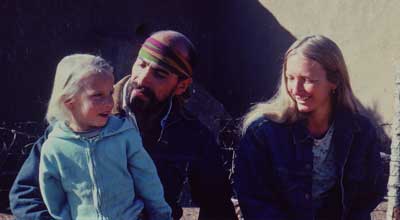I
was delighted by the Covington ladies
and compelled by Drop City, but New
Buffalo: Journals from a Taos Commune
won my heart. This true-life story
by communard and journal-writer Arthur “Arty” Kopecky
consists of diary entries, a few days
to a few weeks apart for seven years,
about life in this famous 1970s commune.
While chronicling the same era and
the same kinds of people as Drop City,
New Buffalo describes a place several
notches more functional than its fictional
counterpart.
Yet there are similarities. The New
Buffalo property was also owned by
a wealthy man who believed in communes,
and everyone was welcome. This was
a time when we believed that with
enough love, freedom, hospitality,
food, and sex, drugs, and rock ’n roll, we didn’t
need rules or agreements. It would
all work out somehow. We would offer
unstinting hospitality at no charge
to the world; this is how we were
changing the world.
Thus New Buffalo—the real-life prototype
for the commune in the movie Easy Rider—had
a total open-door policy. Any freak from anywhere
could visit, stay for dinner, crash in someone’s
room, and end up living there for weeks or for
years. The population fluctuated widely; turnover
was high. There were usually more men than women.
People milked goats, collected eggs, raised
children, mud-plastered the walls, gathered
wood, and conducted the peyote ceremony. There
was no criteria for joining, and no joining
fee. No monthly dues: anyone could donate any
amount any time, nor not. No labor requirements.
People who contributed money and labor supported
those who didn’t. No one had any ownership
in the land, although a few long-term residents
would occasionally be elected to the land’s
governing board of directors. Decisions weren’t
made by consensus or voting, but rather a kind
of amorphous vibe-grok among folks there at
the time. They enjoyed well-prepared food, freely
offered herb, and great dance parties. Men and
women coupled and uncoupled casually, though
not without heartbreak sometimes. New Buffalo
residents drove long distances to trade goods
and labor with friends in the network of northern
New Mexico/Southern Colorado communes. They
did the same with their rural neighbors, whether
Land Grant-Spanish or Taos and Zuni people from
the local pueblos. These white kids from the
city learned to build with adobe, eat chiles
and tortillas, make jewelry of silver and turquoise.
Why did I love this book so much? While dismayed
by the lack of structure and discipline (but
what commune had either in those days?), I was
touched by the kindness and heart of Arty Kopecky’s
perspective. He reported the daily events of
work projects and human interactions matter-of-factly.
He was proud of the commune’s ongoing
generosity and frequent good will. He admired
his fellow residents and was grateful for their
labor or financial contributions. He was approving,
encouraging. He believed New Buffalo would beneficially
impact its visitors, and had hope that it and
other communes like would make a difference
in our society. When he was disappointed in
someone he noted it philosophically. In print,
anyway, while he might observe someone’s
difficulties or shortcomings, he never made
them wrong.
And while New Buffalo doesn’t read like
a novel—it has no plot, and the people
arrive and depart so much it’s hard to
keep them straight—the book does offer
the theme of growth and hope. When the author
arrived in 1971, the place had barely heated
half-finished adobe buildings and leaky roofs,
on acres of high desert land which was frigid
in winter, parched in summer, and muddy and
impassable when it rained. But over seven years
the walls got plastered and roofs fixed. Its
residents learned to build a greenhouse, water
their acres from a local irrigation ditch, plant
vegetables and animal pasturage, and raise dairy
cows and cattle. They finally raised and grew
and traded for most of their own food and had
enough to last the winter.
The first book in a series of two, ends in 1976,
at a high point in the commune’s physical
development. But by this time tension was building
between those who did all the agricultural work
and those who spent most of their time fasting,
praying, and making drums. Some saw New Buffalo’s
purpose as primarily spiritual, with attention
to physical matters only when needed. Others
saw its purpose as agricultural, with growing
food being their spiritual practice. And because
there were no agreements or vision/purpose statements
to fall back on to resolve the dilemma, the
group floundered in conflict. The classic dilemma,
no?
The Epilogue notes that in the next volume of
Arty Kopecky’s journal the conflict escalates
and in 1979 he and his new family depart the
commune “under rather dramatic circumstances.” From
other reading I learned that tension between
the two camps got so heated that everyone left
New Buffalo, and the current owners of the property
operate it as a Bed and Breakfast. I’d
love to stay there some day, so I can see where
the author and his pioneering compadres learned
hard lessons of community, for a few years anyway,
so long ago.
Diana Leafe Christian, editor of Communities
magazine, is author of Creating a Life Together:
Practical Tools to Grow Ecovillages and Intentional
Communities (New Society Publishers). She lives
at Earthaven Ecovillage in North Carolina.
|

